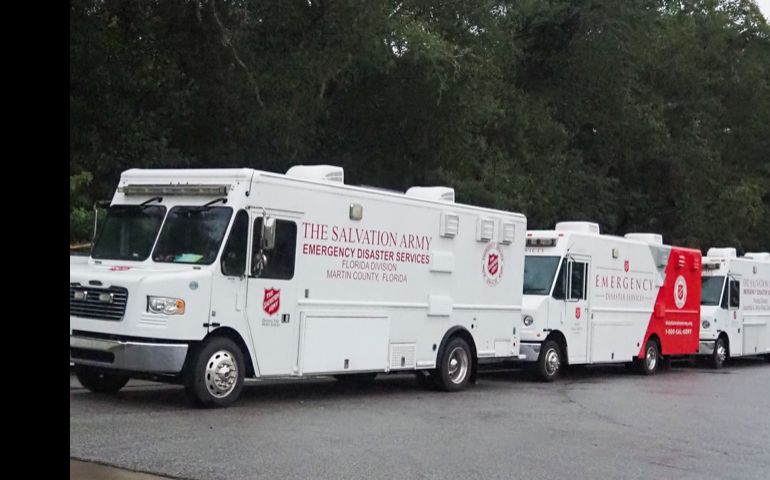The Salvation Army Prepares for Hurricane Ian as Fiona Relief Continues
The Salvation Army | mediarelations@salvationarmyusa.org | (703) 302-8640

Compounding disaster preparation and response efforts make community support vital
ALEXANDRIA, Va., Sept. 28, 2022 /PRNewswire/ -- The Salvation Army is preparing resources and personnel to meet the immediate needs of survivors and first responders ahead of Hurricane Ian's potentially historic landfall in Florida. Ian comes just days after Hurricane Fiona ravaged Puerto Rico, where The Salvation Army is still serving survivors and first responders.
Hurricane Ian is expected to make landfall as a Category 4 storm the night of Wednesday, Sept. 28, on the west coast of Florida. If Hurricane Ian stays on its projected path, it will mark the first direct impact of a hurricane in the area since 1921. Main concerns include a heavy storm surge leading to severe flooding conditions along the coastline. With the entire state of Florida now under a state of emergency and about 1 million residents planning to evacuate ahead of landfall, The Salvation Army is positioning resources and personnel to respond to widespread need as efficiently as possible.
"We are carefully monitoring Hurricane Ian and have mobile feeding units and disaster response teams along the Florida coast prepared to respond," said Major Todd Hawks, Community Relations and Development secretary for The Salvation Army's USA Southern Territory. "This storm has the potential to bring impacts to the west coast of Florida not seen for nearly a century — if ever. With the public's generous support, we will be able to serve this community for as long as we are needed."
On the second front of the recent explosion of hurricane activity, The Salvation Army is continuing to meet the needs of Hurricane Fiona survivors and first responders in Puerto Rico by providing a wide range of emergency services. Many of the communities being served are the same ones who have been dealing with the aftermath of Hurricane Maria which made landfall five years ago.
"Disaster relief is always about the long game," said Bob Myers, Emergency Disaster Services director for The Salvation Army's USA Eastern Territory. "It's about helping people to get their houses and their communities rebuilt. It's also about providing long-term emotional and spiritual care to disaster survivors as much as we can, because sometimes the recovery on the inside can be harder than the recovery on the outside."
Disaster response updates can be found below:
Ian Prep/Initial Response:
- The Salvation Army has as many as 37 canteens (mobile feeding units) and one field kitchen ready to mobilize across the impacted area immediately after the worst effects of the storm are realized.
- Each one of these can feed 500-1,500 people per day
- A caravan including Salvation Army mobile feeding units and a Southern Baptist field kitchen will depart from Texas with over 6,000 pre-made meals and begin feeding Saturday. The field kitchen will begin service Tuesday.
- The Salvation Army is already serving some of the predicted 1M evacuees at a few of their shelters in Florida.
- Two major warehouses in Tampa, Florida and McDonough, Georgia (near Atlanta) are being prepped with food, water, cleaning supplies, hygiene products, and anything else that will be needed by the thousands of people in the storm's path.
Fiona Response:
- The Salvation Army has served more than 18,778 individuals and distributed the following items at its community centers in San Juan, Caguas, Bayamón, Mayagüez, Arecibo, Loíza, Guayama, Humacao, Ponce, Peñuelas, and Fajardo:
- 20,000+ prepared meals, food boxes/meal kits, and snacks
- 19,326 drinks and bottles of water
- 1,942 packs of diapers
- 662 personal hygiene kits
- 519 ice bags
- 990 cleanup kits and cleaning products
- 107 blankets
- Additional services and items provided at some Salvation Army community centers include:
- Charging stations for people to charge personal devices like mobile phones, laptops, portable medical equipment, etc.
- Emotional and spiritual counseling and support
- Clothing for children and adults
- Furniture
The Salvation Army disaster personnel are also collaborating with federal, state, and local emergency management agencies and other social services organizations in both locations to monitor ongoing impacts and adapt response efforts, if necessary.
A digital media kit with current disaster assets can be found here.
For more information on The Salvation Army's continued response, visit disaster.salvationarmyusa.org.
To make a financial gift to support Hurricane relief efforts:
- Donate online: www.HelpSalvationArmy.org
- Donate by phone: 1-800-SAL-ARMY (1-800-725-2769)
One hundred percent of designated disaster donations go to direct services for survivors and first responders.
About The Salvation Army
The Salvation Army annually helps more than 25 million Americans overcome poverty, addiction, and economic hardships through a range of social services. By providing food for the hungry, emergency relief for disaster survivors, rehabilitation for those suffering from drug and alcohol addiction, and clothing and shelter for people in need, The Salvation Army is doing the most good at 7,200 centers of operation around the country. During times of disaster, 100% of designated donations to The Salvation Army are used for immediate response and long-term efforts. In 2021, The Salvation Army was ranked No. 2 on the list of "America's Favorite Charities" by The Chronicle of Philanthropy. For more information, visit SalvationArmyUSA.org. Follow us on Twitter @SalvationArmyUS and #DoingTheMostGood.
About The Salvation ArmyThe Salvation Army annually helps more than 30 million Americans overcome poverty, addiction, and economic hardships through a range of social services. By providing food for the hungry, emergency relief for disaster survivors, rehabilitation for those suffering from drug and alcohol abuse, and clothing and shelter for people in need, The Salvation Army is doing the most good at 7,600 centers of operation around the country. In the first-ever listing of “America’s Favorite Charities” by The Chronicle of Philanthropy, The Salvation Army ranked as the country’s largest privately funded, direct-service nonprofit. For more information, visit www.SalvationArmyUSA.org. Follow us on Twitter @SalvationArmyUS and #DoingTheMostGood.